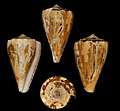Conus princeps
Conus princeps, common name the prince cone, is a species of sea snail, a marine gastropod mollusk in the family Conidae, the cone snails and their allies.[2]
| Conus princeps | |
|---|---|
| Apertural view of shell of Conus princeps Linnaeus, 1758 | |
| Scientific classification | |
| Kingdom: | Animalia |
| Phylum: | Mollusca |
| Class: | Gastropoda |
| Clade: | Caenogastropoda |
| Clade: | Hypsogastropoda |
| Clade: | Neogastropoda |
| Superfamily: | Conoidea |
| Family: | Conidae |
| Genus: | Conus |
| Species: | C. princeps |
| Binomial name | |
| Conus princeps | |
| Synonyms[2] | |
| |
Like all species within the genus Conus, these snails are predatory and venomous. They are capable of "stinging" humans, therefore live ones should be handled carefully or not at all.
Description
The size of the shell varies between 31 mm and 130 mm. The low shell has a distantly but distinctly tuberculated spire, and direct sides, slightly striate at the base. Its color is yellowish brown, orange or pink, sometimes without markings, but usually with irregular longitudinal chestnut or chocolate striations most of which are continuous from spire to base. They vary from fine and close to heavier and more distant markings. The interior is yellow or pink. The epidermis is dark brown, fibrous, with distant revolving series of tufted spots.
The broad-striped state is Conus regius; that with the stripes obsolete is Conus lineolatus.[3]
Distribution
This species occurs in the Pacific Ocean off the coast of Central America, from the Gulf of California (Mexico) to Northern Peru.[3][1]
References
- NatureServe (2013). "Conus princeps". IUCN Red List of Threatened Species. 2013. Retrieved 15 December 2014.CS1 maint: ref=harv (link)
- Conus princeps Linnaeus, 1758. Retrieved through: World Register of Marine Species on 27 March 2010.
- G.W. Tryon (1884) Manual of Conchology, structural and systematic, with illustrations of the species, vol. VI; Philadelphia, Academy of Natural Sciences
- Linnaeus, C. (1758). Systema Naturae per regna tria naturae, secundum classes, ordines, genera, species, cum characteribus, differentiis, synonymis, locis. Editio decima, reformata. Laurentius Salvius: Holmiae. ii, 824 pp.
- Puillandre N., Duda T.F., Meyer C., Olivera B.M. & Bouchet P. (2015). One, four or 100 genera? A new classification of the cone snails. Journal of Molluscan Studies. 81: 1–23
 Conus princeps Linnaeus, C., 1758
Conus princeps Linnaeus, C., 1758 Conus princeps Linnaeus, C., 1758
Conus princeps Linnaeus, C., 1758 holotype of the synonym Conus princeps var. apogrammatus Dall, 1910 in the Smithsonian Institution
holotype of the synonym Conus princeps var. apogrammatus Dall, 1910 in the Smithsonian Institution
External links
- The Conus Biodiversity website
- Cone Shells - Knights of the Sea
- "Ductoconus princeps". Gastropods.com. Retrieved 16 January 2019.
| Wikimedia Commons has media related to Conus princeps. |
